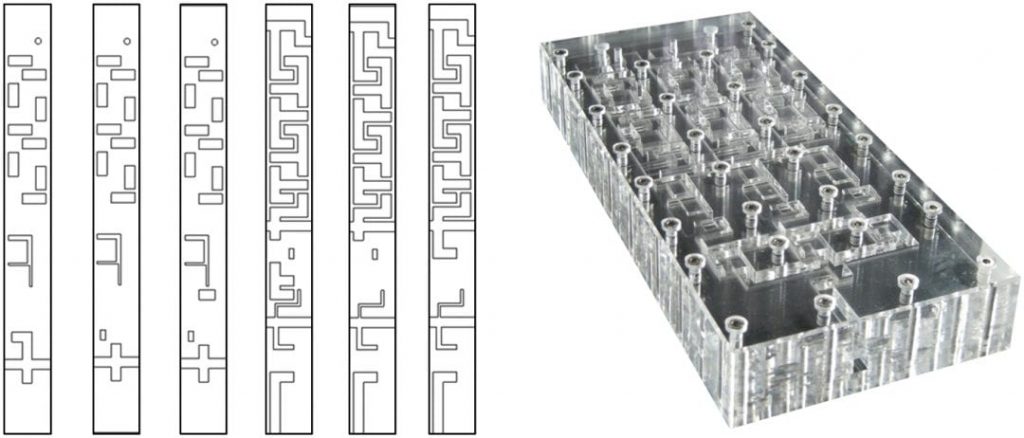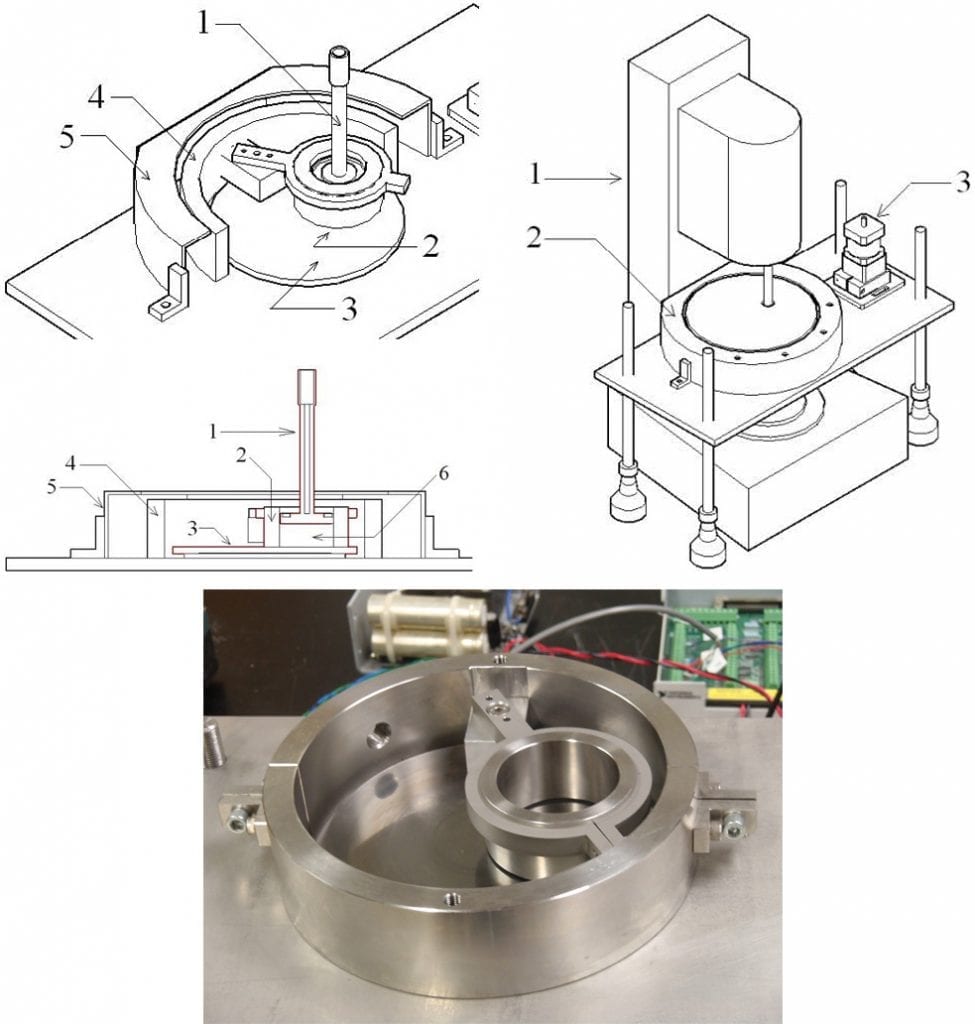At ANTEC 2013 in Cincinnati in April (see Plastics Engineering blog May 10, 2013), plenary speaker Han Meijer from Eindhoven Technical University in the Netherlands (www.mate.tue.nl) startled his audience with the first presentation anywhere of tooling that makes vertical plastic layers as well as horizontal ones. Called “fractal structuring,” the technology creates huge internal surfaces between dissimilar polymers inside a film or molded part. It can also combine polymers of different viscosities in precise layered structures. Seldom has such a major invention with such far reaching implications been published, not patented, leaving it open for further development.
“I looked around the room, and people’s jaws dropped,” was how ANTEC technical program chairman, Mark Spalding, a fellow at The Dow Chemical Co., describes audience reaction. Fractal tooling with vertical layers was invented by Peter Neerincx as the last chapter of his PhD thesis under Meijer, a professor of mechanical engineering and materials technology at Eindhoven TU. Meijer and Neerincx published a paper on earlier fractal tooling in Macromolecular Chemistry and Physics in early 2013.
Neerincx, who now works in process research at Sabic Innovative Plastics BV, Bergen op Zoom in the Netherlands, (www.sabic-ip.com) was “one of those rare students who is gifted in designing and also skilled in injection molding,” Meijer recalls. “Many of our students are good at theory and modeling, but he could make things.”
Fractal structures can of course be made with two polymers in other ways as well, for example, by phase separation or chaotic advection. Phase separation blends dissimilar polymers into a matrix of one material with domains of the other. Chaotic advection blends two polymers into swirling patterns in the melt like marble cake. Both generate fractal interfaces in coextruded or coinjected plastics, but the patterns are random, whereas Neerincx’s fractal patterns are precise and repeatable.
HOW ‘FRACTAL STRUCTURING’ WORKS

Schematics presented at ANTEC show a developmental fractal runner that forms vertical plastic layers as well as horizontal ones for the first time. Boxes 1-10 show cross sections of the fractally patterned melt flow with vertical layer elements at numbered points in the runner.
Neerincx started by analyzing fluid flow patterns in static mixers, which was also the starting point for chaotic advection tooling in the 1980s. He worked with Tae Gon Kang, Sven Peelen, and Roel P. J. Denteneer, also graduate students at Eindhoven at the time, to modify a known mixing element so that it could form multiple layers. These mixing elements were known as the Dentincx and Peelincx Mixers and were reported in Macromolecular Materials and Engineering in 2011. The Dentincx Mixer is linear, the Peelincx Mixer is circular. Both form layers, slice them in the machine direction, and rotate half of the multilayer material in two successive 90-degree turns back onto itself. But at the end of the day, high numbers of layers are also made commercially by other technologies (see Plastics Engineering blog July 6, 2012).
The big breakthrough came when Meijer and Neerincx realized the potential of splitting the serpentine 90-degree rotation of the layering devices and turning the two halves of the multilayer flow on their sides. This created vertical layers in the melt for the first time ever, allowing layers to be formed perpendicular to a part surface or sandwiching vertical layers between horizontal ones.
The concept of perpendicular layers on horizontal layers isn’t totally new, however. It exists in some nanostructured film technologies and self-assembled chemical coatings and is used to create porosity, co-continuity or electrical conductivity in films for photo voltaics and batteries. Not surprisingly, Neerincx’s fractal structuring with perpendicular plastic layers also targets photo voltaics and batteries. But it has the advantage that it can potentially be done in a single environmentally friendly process vs. less controlled and environmentally hazardous coating technologies used in photo voltaics today.
SIX ‘FRACTAL’ MIXING ELEMENTS
Neerincx designed and built eight different sets of injection mold tools in the course of his PhD research over a five-year period, 2007-2012. Each tool formed one chapter of his thesis with the last chapter on the vertical fractal layers. Neerincx verified most of the tooling designs on a Ferromatic K-tec 60 two component lab injection press with a vertical and a horizontal plastification unit. Thermoplastic tests used black and white PS, PC and PP with 3% titanium dioxide for white and 3% carbon black for black.

Vertical-layer structuring was invented by Eindhoven Technical University professor Han Meijer and PhD student Peter Neerincx, who built this fractal runner out of laser-cut PMMA plates and molded black and white epoxy into a tree pattern with a trunk, branches, and leaves.
The runners for the fractal structuring, however, were built of laser-cut plates of clear polymethyl methacrylate (PMMA), stacked and bolted together and the designs verified using black and white epoxy, cured at room temperature. Fractal tooling uses six different mixing elements: flow splitting, flow addition, right flow rotation, left flow rotation, right flow rotation with flow addition, and left flow rotation with flow addition. Layer multiplication takes flow splitting, either horizontal or vertical, and flow rotation. Hierarchic designs start with layers, then take flow rotation and flow addition.

This fractal runner system was modified by enlarging the melt channels to avoid compressing and distorting vertical layer elements. The tool was cut out of 27 laser-cut PMMA plates bolted together, whereas the original fractal “tree” runner was made of only eight PMMA plates.
Neerincx’s fractal runners ranged from a stack of eight PMMA plates for a simple “tree” pattern up to 27 plates for the most complex pattern. The eight-plate fractal runner for a tree forms a trunk, two branches, and 16 leaves. It starts with a serpentine melt channel with two mixing elements that form 32 black and white layers for 16 black leaves, i.e., each mixing element multiplies the layers times four. Then branches are formed. A side layer of white is coinjected on one side and black on the other, putting half a branch onto the leaves. This half-branch-leaf structure is split, stretched, and rotated 90 degrees twice to form two branches, each with eight leaves, four on each side. The largest rotation in the hierarchy, for the tree trunk, comes last just before the pattern enters the mold. Black and white side layers are coinjected outside to form halves of the trunk. This structure is split and rotated to complete the tree. “Then a black ‘ground’ layer and white ‘sky’ layer were added on the sides, and the structure was rotated 90 degrees to make the tree stand up,” Meijer explains.
Neerincx’s most complicated fractal runner used eight mixing elements to make 130,000 black and white layers for 65,000 black leaves. It wasn’t easy to get a pattern like that into the mold without smearing. Even if the pattern didn’t disappear, vertical and horizontal layers behave differently in the runner. Horizontal layers are stretched thinner and flatter as the structure moves in the machine direction. Vertical layers are compressed, becoming shorter and fatter and curling.
Neerincx found several things helped preserve the pattern. One was to keep enlarging the height and width of the melt channel as layers and rotations were added to avoid compressing and distorting the design. Another modification that helped was to extend the pattern across the whole width of the part before the plastic entered the mold. In one complex runner system, for example, Neerincx used five modified mixers initially to create 8,000 layers. He then used eight co-injection units side by side to extend the pattern to the width of the mold. The horizontal stack of 8,000 layers was split into eight flows, each with 8,000 layers. White layers were coinjected on both sides. Then all eight square structures with a total of 64,000 horizontal black/white layers with white on both sides were cut and rotated to make a three-layer structure with 64,000 vertical layers in the middle and a white layer on the top and bottom.
After that a phenomenon known as “fountain flow” converts the three-layer structure into a five-layer one. When the layered structure reaches the front of the injection mold, the material in the middle is flowing faster than the material along the walls. This “fountain flow” effect splits the middle layer in two and creates a five-layer structure with 64,000 vertical layers on the top and bottom, separated by two white layers from 64,000 vertical layers in the middle. Fountain flow also affects injection molding of a tree pattern. First, enough polymer has to be injected into the mold to accommodate fountain flow along the walls. Then the fractal structure with the tree design can be coinjected into the center of the mold.
WHAT’S AHEAD FOR ‘FRACTAL STRUCTURING’?
Meijer and his students started fractal structuring in injection molding, but the technology is likely to be commercialized first in film. Film research continues on two fronts. Tetra Pak in Lund, Sweden, a division of Tetra Laval Holdings & Finance S.A., (www.tetrapak.com) bought rights to develop precise multi-layering for high-strength, high performance films (WO Pat. Applic. # 2012/095457) and is continuing research.

Eindhoven TU and ETH institute in Zurich are now testing three-component films with complex fractal hierarchies like these, creating huge internal surfaces that no longer resemble trees. The technology targets less expensive films for photo voltaics and batteries.
Meijer also works with Paul Smith, professor of polymer technology at the ETH institute (Eidgenoessische Technische Hochschule) in Zurich, Switzerland, (www.ethz.ch) developing three-material fractal films—two active fractal polymers and a third for support. They have built metal tooling for films with hundreds of trees, thousands of branches, and hundreds of thousands of leaves and are developing fractal films up to 12 cm wide and down to 2 microns thick. They are testing classic photovoltaic conductive organics like poly(3-hexylthyophene) (P3HT) and [6,6]-phenyl-C61-butyric acid methylester (PCBM) blended into standard polyethylenes.
The tooling for vertical layers may be revolutionary and exciting, but it also still has to be adapted to commercial conditions. “The question,” as Meijer puts it, “is whether we can use simple geometries inside simple dies, allowing compression flows to wrinkle and crinkle huge stacks of leaflets, and then later straighten them out and unfold them during transverse stretching in the slit die.” In other words, can they create unlimited internal surfaces in plastic film in a single processing step and then orient the film without losing the internal structure?
New test methods may also be needed to measure the viscosity of fractally structured materials. Interestingly, another ANTEC paper this year addressed the issue of testing materials with internal fractal structures produced by chaotic advection, not by vertical-layer tooling. Subramanian Ramaswami, a graduate researcher, and David Zumbrunnen, professor at Clemson University, Clemson, SC, (www.clemson.edu) presented “A Device for Simultaneous In-Situ Structuring and Measurement of Rheological Properties of Polymer Blends and Composites.”

Standard viscosity tests may not be applicable to films with internal fractal structures. A rheometer developed at Clemson University and introduced at ANTEC fits into commercial rheometers and tests shear viscosity of fractally structured materials made by chaotic advection.
Their in situ structuring rheometer fits into existing commercial rheometers and has the test capabilities of the commercial rheometer, typically testing shear viscosity and viscoelastic properties. But it can perform these tests on two-polymer blends made with chaotic advection structuring. Zumbrunnen previously developed a chaotic advection device using independently rotating stir rods in a barrel to create swirling patterns in extruded or injection molded plastic. The technology is available for license from Clemson, which has sold or licensed about half a dozen chaotic advection devices.

















